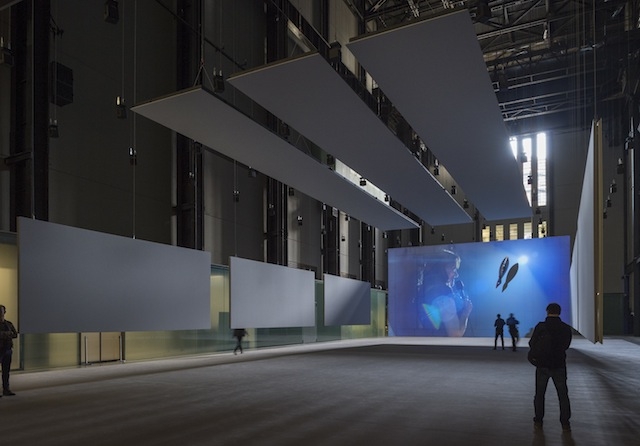Hyundai Commission, Tate Modern, London 4 October – 2 April 2017
Successfully activating Tate Modern’s Turbine Hall for the institution’s annual commission is a tough gig. After Anish Kapoor filled the space physically with Marsyas (2002), Olafur Eliasson charged it with an atmospheric experience for The Weather Project (2003) and Bruce Nauman occupied it aurally with Raw Materials (2004), the pressure has been for artists to come up with increasingly innovative propositions. With a history of creating non-narrative installations that animate a space through a combination of orchestrated sound, light and movement, Philippe Parreno already seems a perfect fit, and what he’s done here only confirms that suspicion. For the ears there is an ever-changing succession of sounds, some miked-up to and fed in from the building itself, others not, including a thunderstorm, snippets of children’s voices and layers of buzzing, humming and ominous musical tones. For the eyes: Parreno’s signature helium-filled fish balloons (species specific to the location) gently bobbing about; strips and blocks of lighting, some part of the existing fabric of the building, others created, that pulse on and off; a large screen that descends and ascends into the centre of the space, onto which a sequence of coloured lights may be projected. The screen is accompanied (or not) by a series of horizontal and vertical flats that also rise and fall, creating a semi-enclosed viewing space in front of the screen. When this occurs, a short film plays, featuring ventriloquist Nina Conti and footage of a cuttlefish in a tank. Between these events there is sometimes just stillness and silence.
It’s when the film plays that Parreno’s interest in artificial, digital and organic life, and how that life communicates, becomes more explicit. Conti ventriloquises lines about transparency and diaphaneity and about how “the mask is the first automaton”. Meanwhile the cuttlefish, in its strangeness, especially when shown in extreme closeup, appears as a benign and almost alien intelligence. Despite Conti being highly skilled in her art, the combination of her clipped delivery and the powerful but echoey audio speakers through which it’s delivered often hinders the understanding of her words. Maybe this is intentional. It’s probably also no coincidence that Parreno presents us with a cuttlefish, a creature that can communicate through changes in chromatic skin colouration, skin texture and movement.
There is another lifeform at work here too. In a small room at the back of the Turbine Hall, cloudy yeast cultures growing in glass jars are connected by an impressive array of wires, tubes and digital displays to a series of monitors. It’s this bioreactor, we are told, responding to changes in the hall’s temperature and atmospheric conditions, that is controlling the sequence in which the events occur. Parreno has, by bringing life to the Turbine Hall, as close as possible brought the Turbine Hall to life.
This article first appeared in the December 2016 issue of ArtReview
